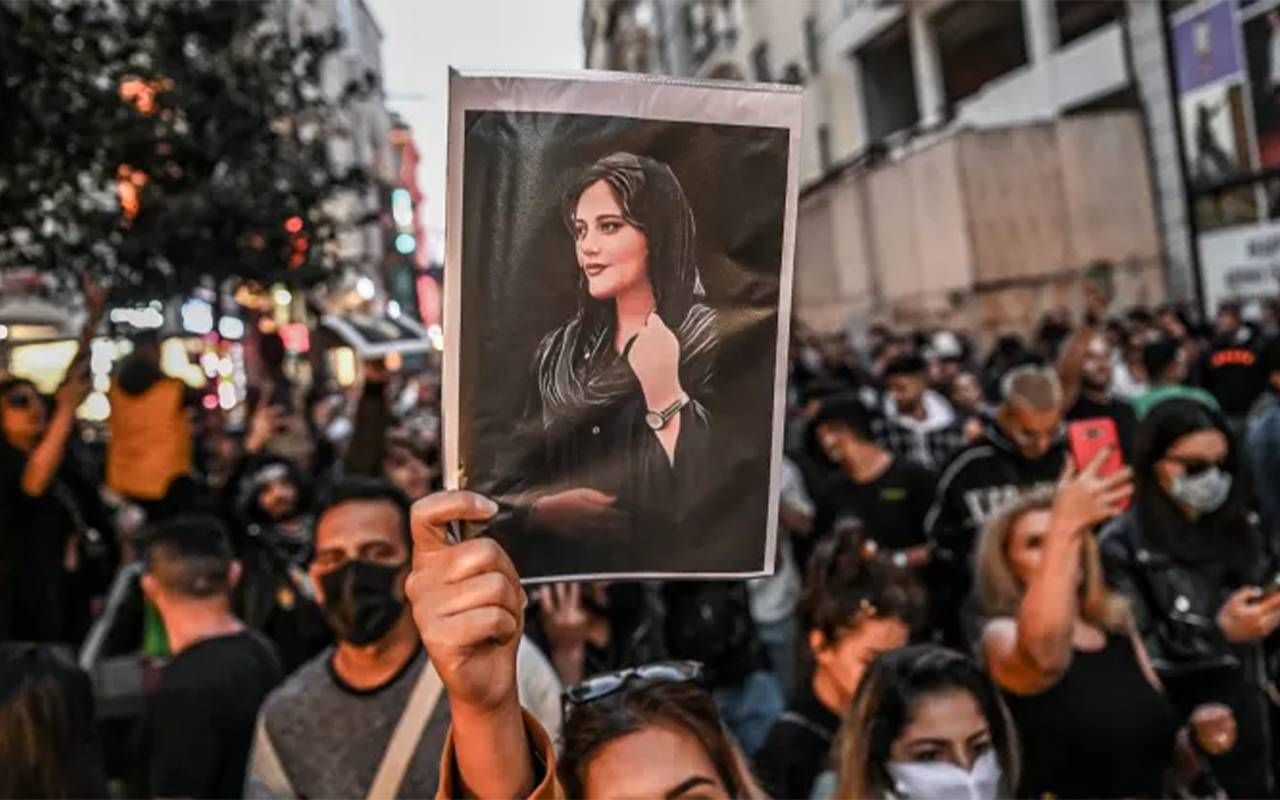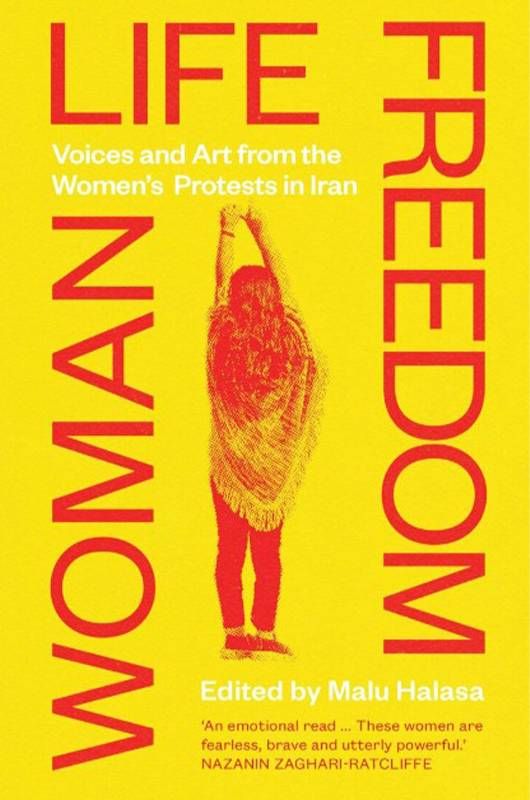Woman Life Freedom
A new anthology presents voices and art from the women’s protests in Iran
After years of simmering unrest, a single event ignited a revolution in Iran. That event was the death of Jina Mahsa Amini, a Kurdish woman, in September 2022. She died in police custody following her arrest for allegedly not wearing the mandatory headscarf called hijab.

"Woman, Life, Freedom" is the rallying cry of the revolution. It is also the title of an anthology by artists and writers in Iran, which was published in the United States earlier this month.
Amini was not the first or only woman arrested for nonconformity. The United Nations says Iran's Morality Police arrested 20,000 young adults last year for allegedly violating a strict dress code handed down by the country's religious leaders. Women without hijab are increasingly common in Iranian society, but their lives remain in danger.
"These women are prized. They're not outlaws. Change is afoot in Iran."
The contributors to this anthology speak out for self-determination through essays, photography, paintings, stencils and posters. We hear their defiance and their fear. We get to know them in translation from Persian, in their own writing and in interviews.
They put themselves at risk by allowing their names, their stories and their art to be included in the book. They could be arrested, tortured or killed for their participation. When Malu Halasa, editor of "Woman Life Freedom," worried about the risks the contributors were taking, one of the project's interpreters told her, "What you have to understand is that every day, Iranians make a calculation about whether they want to be seen or not seen. Trust your contributors. They made that calculation."
Halasa, 67, has edited seven anthologies on Middle Eastern art and culture. Of Jordanian and Philippine descent, Halasa spent much of her youth in Ohio, was educated at Columbia University, and now lives in London. She is literary editor of The Markaz (Marrakech) Review.
Woman Is Singular for a Reason
It is not an accident of translation that "Woman" is singular. The protest cry "comes from a Kurdish saying about the liberation of women," Halasa said. "The power resides in the individual woman. It's not just a group. It's each individual woman. It could be any woman."
Western readers may not comprehend the blurred lines of tradition, religion and politics that require an Iranian woman to cover her head. It may be difficult to understand the fear of being caught without hijab and the possibility of arrest and death. What Westerners can appreciate is the urgent desire to break out of a restrictive pattern and to find expression in art and literature.
Mandatory wearing of the hijab is a relatively new phenomenon. When Mohammad Reza led Iran as Shah, from 1940 to 1979, women had greater freedom than now. The Shah's twin sister, Ashraf Phalavi, was an advocate for women's rights who spoke at the United Nations in the Year of the Woman in 1975.
The hijab requirement went into effect in 1979, when Ayatollah Khomeini, a religious leader, ousted the Shah and declared himself Supreme Leader. Khomeini's authoritarian regime imposed a strict set of rules for all residents, especially women. "It all comes down to the body, the female body, and who has control of it," Halasa said. "It has the color of religion over it, but it's a patriarchy."
Simmering Resistance Boils Over
Recent generations have lived under the hijab law, knowing their mothers and grandmothers enjoyed greater freedom. Small protests rumbled through Iran from time to time. The number started to increase in 2017. With Amini's death, the nationwide movement boiled over.

Women are at the front of the protests throughout Iran, but the men who join them also take their chances. According to the U.S. State Department website, "Today the Iranian regime under the Islamic Republic's rule routinely punishes activists and religious and ethnic minorities for peaceful activities, preventing the free exercise of belief and expression."
The Morality Police, designated by Iran's leaders as enforcers of the hijab law and related restrictions, consists of several vaguely defined groups. They are in uniform and in plain clothes, male and female. Many are armed.
A Formidable Opponent
Halasa said she is angered by the imprisonment of personal friends as well as the arrests and deaths of people she has never met. "You immediately know what side you're on," she said. "The stakes are very high, and the regime is a formidable opponent."
In several chapters of "Woman Life Freedom," artists share portraits of women who have disappeared or died after breaking from cultural norms. Singing was the crime of some. It is illegal for a woman to perform as a solo singer.
The book contains shocking accounts of deaths caught on phone video. One essay details a case of mental illness blamed on having witnessed violence.
The anthology honors women who have been shot in the streets for shouting anti-regime slogans and for cutting their hair.
Public and Private Defiance
In one chapter, photographs of young women tell the story of hair color as an act of rebellion. Green, purple, blue and orange dye, sometimes half and half, are statements of an unwillingness to follow tradition.
"Iran has a very deep visual culture," Halasa said. Poster art has a long history as a form of protest. In hasty bursts of spray paint, stenciled portraits of imprisoned women show up on walls and street posts.
"It's the strength of the material by Iranians to Iranians that convinced people to be in the book."
Although many protests are public, some acts of rebellion take place in private. In a culture in which women's clothing is designed and controlled by men, underground fashion shows feature models in tight, strapless gowns, adorned with feathers, sequins and three-inch heels. Those styles are considered unacceptable by the authorities. Any kind of fashion show is illegal.
Technology is an asset to the protesters. They use an underground network of apps and internet connections to disseminate information, arrange events, share viral songs and stay in touch.
"Woman Life Freedom" is an inclusive anthology, featuring women of various ages and sexual orientation. Supportive men are represented in the book by one writer, several artists and many translators.
"It's the strength of the material by Iranians to Iranians that convinced people to be in the book," Halasa said.
Even with high stakes for being caught, acceptance is growing for women who express their individuality.
Support from Many Strangers
One essayist in the anthology expressed the fear she felt as she traveled through town without hijab. When she was approached by an older woman in a burka, an extremely conservative form of women's clothing, the unveiled woman had a moment of panic. She thought she would be attacked or reported to authorities. It turned out the older woman just wanted to ask directions. As she went on her way, the elder said, "Take care of yourself, my daughter."
"Even the most conservative people who ran the bazaar were supporting the women," Halasa said. "Oil workers were supporting the women. Pensioners were supporting the women.
"These women are prized. They're not outlaws. Change is afoot in Iran."


